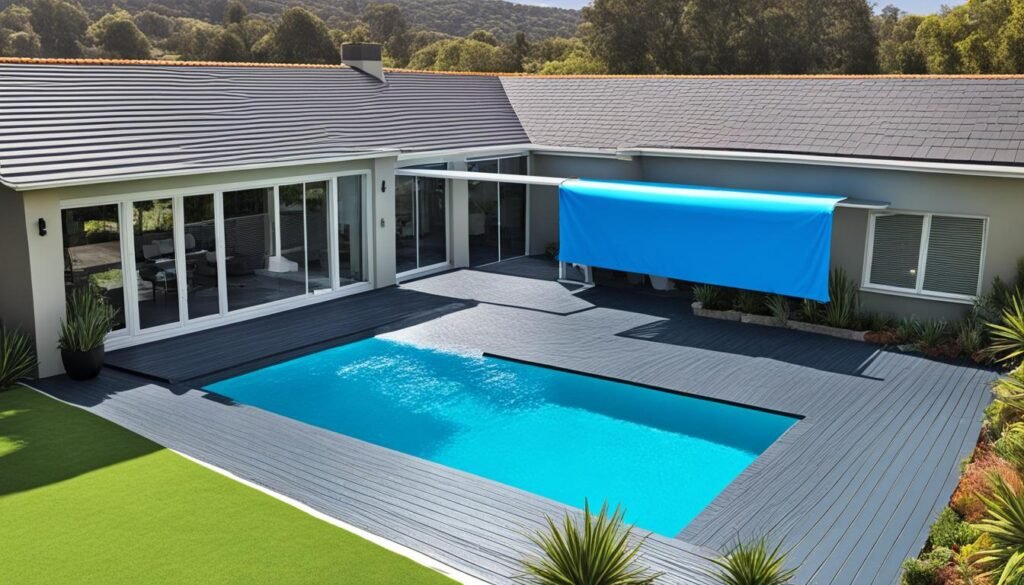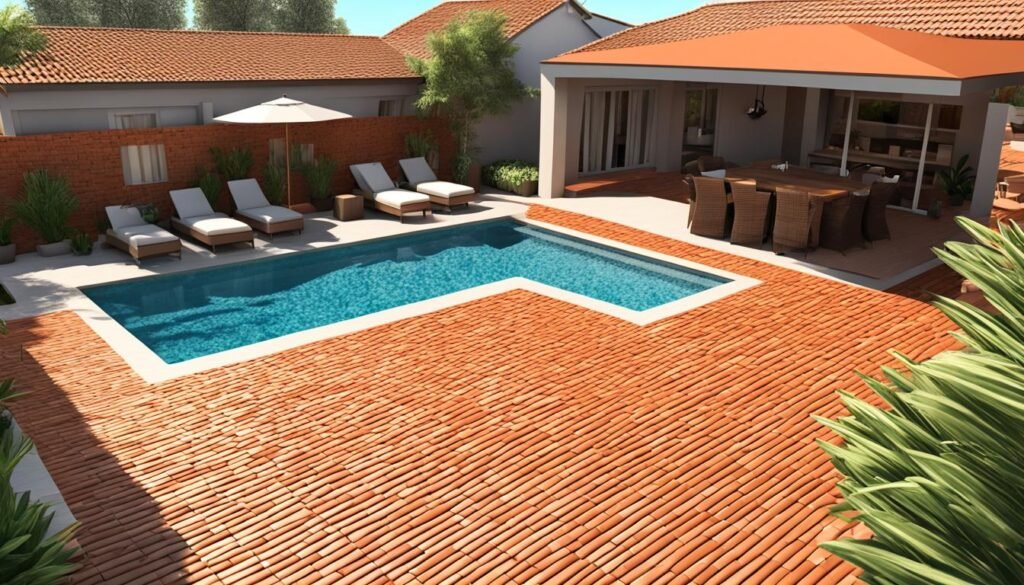When it comes to selecting the best color for pool cover, homeowners in South Africa are faced with an array of choices that are not only functional but also enhance the aesthetics of their outdoor space. Delving into the myriad of top pool cover colors, it becomes evident that the choice extends beyond visual appeal, playing a critical role in pool maintenance and energy conservation. From the heat-absorbing properties of black tinted pool covers to the modern look of PVC safety covers, the range of popular pool cover color options caters to diverse preferences and needs. Achieve the perfect balance between form and function with effective pool cover colors tailored to South African homes.
Key Takeaways
- Black and dark-colored pool covers are prime for reducing light penetration and deterring algae growth.
- Safety nets offer an economical solution while PVC covers provide a sleek appearance.
- Automation in pool covers conveys a sense of luxury and operational simplicity, ideal for those prioritizing convenience.
- For those considering rainwater management, consider bar covers with weep holes or automated covers paired with water pumps.
- Choosing a pool cover color is a strategic decision that influences savings in maintenance costs and chemical usage over time.
What color pool cover is best?
Choosing the right pool cover color is not just a matter of aesthetics, but also of functionality, energy efficiency, and maintenance savings. In the South African context, where pools are subject to harsh sunlight and environmental debris, the color of a pool cover can significantly affect the pool’s temperature control, resistance to algae growth, and overall energy consumption.
Understanding the Benefits of Different Pool Cover Colors
Pool covers come in various hues, each with distinct benefits. Opaque covers, for instance, promote better insulation and decreased algae growth, while translucent covers excel in harnessing solar energy to warm your pool. Homeowners need to consider the optimal pool cover hue that best complements their pool’s functional needs.
Optimizing Energy and Maintenance with the Right Color
The ideal swimming pool cover color is one that achieves a balance between energy efficiency and maintenance ease. Materials with a perfect blend of pigmentation and transparency can effectively minimize heat loss. Among the popular pool cover color options, certain shades are engineered to provide both thermal benefits and reduce chemical demands.
Comparative Insights: Dark vs. Light Colors for Heat Retention
Lighter pool cover shades might appear less efficient at first glance, but their ability to reflect heat evenly across the pool can lead to increased water temperatures. This comparison showcases that sometimes the recommended pool cover shades may diverge from common perceptions about dark colors and absorption.
Color Impact on Algae Growth and Chemical Usage
Managing algae growth is a crucial aspect of pool maintenance. Effective pool cover colors are the ones that also contribute to reduced reliance on chemicals for algae control. By mitigating light penetration, certain pool cover colors inhibit algae proliferation, illustrating that the best color for pool cover is one that suits both the environmental and maintenance needs of a South African pool owner.
Analyzing Pool Cover Costs and Material Benefits
When homeowners in South Africa deliberate on what color pool cover is best, they must consider the broader financial implications tied to the pool cover materials. Not only do these materials determine the aesthetic and functional appeal, but they also bear on the long-term value offered through features such as enhanced safety, cleanliness, and heat retention. Examining the ideal swimming pool cover color involves evaluating cost efficiency against these tangible benefits.
| Pool Cover Type | Price Range (ZAR) | Expected Benefits |
|---|---|---|
| Manual Covers | R5,000 – R40,000 | Cost-effective, user-operated protection |
| Automated Covers | R100,000 – R400,000 | Convenience, enhanced safety, high-end aesthetics |
| EnergyGuard™ Selective Transmission Cover | Varies with size and dealer | Algae prevention, heat retention, evaporation control |
| Sol+Guard™ Cover | Varies with size and dealer | Maximizes solar energy gain, extends swimming season |

As the South African market showcases, manual pool covers are the starting point for those budget-conscious, ranging from affordable options to more premium variants. Advanced materials found in automated covers, which begin at a surfeit price, reflect a commitment to pooling investments that value safety and ease of maintenance alongside the potential for heating the pool through solar energy.
Specific products such as the EnergyGuard™ Selective Transmission and Sol+Guard™ covers are fine examples of how initial costs are offset by long-term savings. These covers not only cater to the question of what color pool cover is best, but they also showcase technological innovation through their unique material properties, offering a host of benefits, including heat retention and significant reductions in evaporation and chemical consumption.
Conclusion
In the search for the ideal pool cover shade for South African homes, an intersection of practicality and aesthetic appeal is key. The significance of a pool cover extends far beyond its exterior contribution to the home’s outdoor space. It is, therefore, necessary for homeowners to meticulously appraise the attributes each color offers. Understanding how the chromatic choice influences the swimming pool’s temperature, maintenance demands, and its role in preventing unwanted biological growth is essential in making a final decision.
Final Thoughts on Selecting the Ideal Pool Cover Shade
In drawing together the multifaceted aspects of safety, water preservation, and energy competence, the selection of a pool cover color should fulfill the distinctive requirements of the homeowner. Effective pool cover colors possess the potential to curb algae proliferation and diminish the frequency and amount of chemical treatments required. Thus, identifying the recommended pool cover shades that cater to specific preferences, whether for boosting solar heat accumulation or for being proactive in algae deterrence, remains a pivotal aspect of pool ownership.
How the Best Color Choice Translates to Long-Term Savings
The pursuit of the optimal pool cover hue encompasses more than just aesthetic satisfaction; it is a strategic choice that can lead to substantial savings over time. By striking a balance between heat conservation, algae management, and chemical utilization needs, households can pinpoint the shade that not only maintains the pool’s integrity but also accentuates eco-friendly practices. Given the climatic nuances of South Africa and the imperatives of pool upkeep, the chosen pool cover color is paramount in promoting energy-efficient living and sustaining the pool’s condition irrespective of the season. When asking, “What color pool cover is best?” consider the amalgamation of these savings as an investment in your property’s efficiency and environmental harmony.
FAQ
What is the best color for a pool cover in South Africa?
The best color for a pool cover depends on your specific needs. Light blue covers are great for heat retention, while opaque colors like black or dark blue can prevent algae growth and reduce chemical usage.
What are the top pool cover colors in terms of effectiveness?
Effective pool cover colors include light blue for optimal heat retention and darker shades for preventing algae growth and minimizing chemical use.
Which pool cover colors are most popular in South Africa?
Popular pool cover color options in South Africa include light blue for heating the pool water and black or dark blue for their algae-preventing properties.
How do different pool cover colors optimize energy and maintenance?
Lighter colors can maximize solar gains and heat the water effectively, while darker, opaque pool covers can help conserve energy by reducing algae growth and the resultant need for pool chemicals.
What are the advantages of dark vs. light pool covers for heat retention?
Light pool covers can increase water temperatures by allowing more sunlight to heat the pool, while dark covers absorb sunlight but may not transfer heat as effectively to the water below.
How does the color of a pool cover impact algae growth and chemical usage?
Opaque pool covers block sunlight, which is necessary for algae to thrive. By limiting light penetration, less algae grow, which subsequently reduces the amount of chemicals needed to keep the pool clean.
Are there long-term savings associated with choosing the right pool cover color?
Yes, selecting a pool cover with the ideal shade can contribute to long-term savings through reduced water, energy, and chemical consumption. The right color can influence the pool’s temperature, maintenance needs, and algae control, providing both ecological and economic benefits.
How can I decide what color pool cover is best?
Consider the primary objectives for your pool cover, such as heat retention, algae control, or aesthetics. Assess the potential energy savings, maintenance implications, and overall look to decide on the optimal color for your pool cover.
Does the color of the pool cover affect safety features?
While color mainly affects the thermal and maintenance characteristics of the pool cover, it can indirectly impact safety. For example, darker covers may make it harder to see through the water, while lighter covers provide more visibility.
What material benefits should be considered alongside color when choosing a pool cover?
When choosing a pool cover, consider the material’s durability, resistance to UV degradation, and ability to withstand the local climate. Some advanced materials offer additional benefits like selective transmission for heating and algae prevention, which can justify a higher initial investment.

